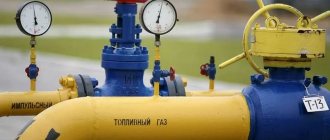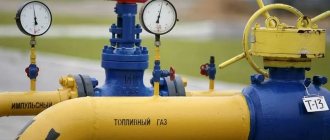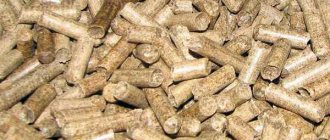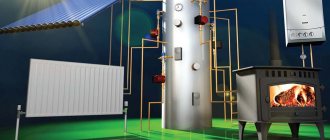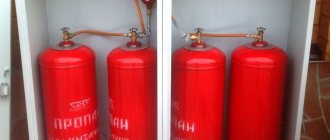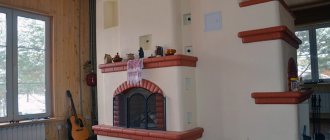Autonomous gasification has two significant columns in the estimate: installation of a gas tank and annual fuel consumption. We will tell you how much you will spend on liquefied petroleum gas (LPG) when living in an area of 50 to 800 m2.
The entire article in 1 table
| Popular house sizes | Gas consumption per month | Gas consumption during the heating season (7 months) | Gas consumption per year |
| 100 m2 | 316 l | 2,212 l | 3,802 l |
| RUB 5,624 | RUB 39,368 | 67,000 rub. | |
| 150 m2 | 475 l | 3,325 l | 5,703 l |
| RUB 8,455 | RUB 59,185 | 101,000 rub. | |
| 200 m2 | 633 l | 4,431 l | 7,603 l |
| RUB 11,267 | RUR 78,869 | 135,000 rub. |
LPG at a price of 17.80 rubles/l as of 01/29/2019.
Gas consumption calculator for home heating
LPG consumption can be calculated in 3 ways: by boiler power, house area and the Soviet formula (27 liters per m2 per year). All options give an average result, because they are divorced from real living conditions.
We made a calculator based on heat loss at home. The room warms up correctly if the heating compensates for the thermal energy that the building loses through the roof, doors, walls, windows per unit of time.
The calculations include the height of the ceilings, the presence of an attic or basement, and building materials with different heat losses:
- foam blocks - 32.7 kW/m2;
- brick - 27.6 kW/m2;
- wood - 26.1 kW/m2.
Calculate online
House area (m2)
Ceiling height (m)
Attic
Basement
House material
How exactly does the calculation take place?
The final indicator of LPG consumption per year is derived using several formulas:
- We calculate the gas consumption without hot water (kW/h): house area × ceiling height × heat loss of the material × attic and basement coefficient.
- We find the gas consumption with DHW (kW/h): consumption without DHW × coefficient for DHW.
- We convert the kW/h indicator to Kcal/h, then to m3/h, then to l/h.
- We calculate the annual consumption: l/h × boiler operating hours per year.
In the calculation process, we take into account a number of indicators:
- The coefficient for DHW accounting is 1.15.
- The coefficient of the attic and heated basement is 0.95.
- The coefficient of the attic and unheated basement is 1.
- Coefficient without attic + heated basement - 1.
- Coefficient without attic + unheated basement - 1.05.
- The coefficient without an attic and without a basement is 1.1.
- The coefficient for converting energy (kW) into calories (Kcal) is 1.163.
- The conversion factor from m3 to liters of LPG is 2.37.
- Boiler operating hours per year - 2,265.
- Boiler efficiency is 0.92.
Unaccounted variables for gas consumption in a private home
The calculator still produces an average result. For accurate forecasting, much more data is needed:
- Required room temperature.
- Average temperature of the coldest week of the year.
- The number of windows, their height and width.
- Ratio of window to floor area: 10–50%.
- Window type: regular double glazed, double glazed, double glazed.
- Number of floors, upper and lower floors.
- Characteristics of external walls:
- masonry of 1-3 bricks with a thickness of 25–76 cm;
- log house made of logs with a diameter of 20–25 cm;
- log house made of timber 10–20 cm thick;
- frame wall 20 cm thick (board, mineral wool, board);
- foam concrete 20–30 cm thick.
Important adjustments are made by in-house gas equipment:
- number of burners on the stove;
- presence of an oven;
- real (not nameplate!) power of the gas boiler;
- device type: standard or condensing boiler.
A condensing boiler uses the potential of water vapor from gas combustion products. The equipment uses the generated heat as efficiently as possible and reduces fuel consumption by 15%.
By the way
If you want to determine the gas consumption for your home taking into account all the data, contact an engineer.
Count for me
What measures can be taken to reduce gas consumption
It is possible that the calculations carried out will lead one or another house owner into confusion: “And this is called economical heating?!”
If such disturbance has arisen, then it is necessary to look for the reasons that lead to the inefficient use of energy resources. It is necessary to carefully analyze what can be changed in order to reach a normal level of consumption. It is clear that it is simply impossible to change the area of the house, its location, or the climatic conditions of the area where you live. But many measures leading to saving thermal energy are quite feasible.
- The first and, perhaps, most important thing is that you need to audit the thermal insulation system of your house or apartment - this will dramatically reduce heat losses in the premises.
The illustration below shows in different colors the main paths through which heat leaves the house, as well as recommended measures to prevent unnecessary heat loss.
Maintaining a comfortable microclimate in an uninsulated house is too complicated, wasteful, and, frankly, unreasonable.
Work on thermal insulation should not be carried out at random, but with the necessary thermal calculations. Yes, this can be a very expensive undertaking, but you can rest assured that the costs incurred will be repaid a hundredfold - this includes a healthy microclimate in the house, the durability of building structures, and a sharp reduction in operating costs for heating the building.
Thermal insulation issues are at the forefront!
There is a whole section devoted to the topic of thermal insulation of buildings on our portal - literally all aspects of this area of individual construction are considered. insulation materials for walls are presented in great detail - with an attached methodology for independently calculating the thickness of thermal insulation. A number of publications talk about the insulation of ceilings and floors . Many people don’t even know how important high-quality thermal insulation of the base . And there is a lot of other versatile and useful information - all this is in the section of our portal “House insulation” .
- Replacing old wooden windows with modern ones equipped with double-glazed windows will be of great benefit. Heat loss will decrease sharply - and this will immediately result in tangible savings in gas consumption.
Is it time to replace your windows?
In order not to be disappointed in the purchase, the purchase of new windows must be treated with the utmost responsibility. about many important nuances of choosing PVC windows in a special publication on our portal.
- It is possible that your old boiler is very far from perfect. The author of these lines once purchased a house with an old cast-iron APOC unit, and during the first winter he had to pay for 800 cubic meters of gas per month - and this with an area of only 80 square meters and in a mild southern climate. The first purchase next year was an AOGV-11.6 boiler and circulation pump. The results exceeded our wildest expectations - consumption decreased fourfold, and the purchase of new equipment paid for itself in just a couple of years.
- It is necessary to correctly select and rationally arrange heating radiators in the rooms and, if possible, equip them with thermostatic devices. In addition, even the simplest devices can be used, for example, a reflective screen of foil polyethylene foam - it will significantly reduce absolutely unnecessary heat loss.
Such an improvement costs pennies, anyone can install it, and the effect will immediately make itself felt.
It is important not only to choose the right radiators for each room, but also to ensure their optimal connection to the circuit in order to achieve maximum heat transfer - this can also be one of the sources of savings gas
Don't know which radiators to choose?
Modern hardware stores offer a wide selection of heating batteries, and this can sometimes even confuse the buyer. Recommendations for choosing heating radiators are in a special publication on our portal.
- Innovative digital technologies come to the aid of people. Many models of modern heating equipment are equipped with automation units connected to temperature sensors in the rooms. This allows you to achieve optimal distribution of generated energy, carry out daily and weekly programming of system operating modes, when, for example, some rooms are switched to energy-saving mode in the absence of the owners, but optimal conditions will be recreated in the house by their arrival. Expensive, of course, but it's worth it!
One more thing. It is possible that the problem can generally be solved by “administrative measures.” A fairly common picture is that it’s freezing outside, but the windows in the house are wide open, and the heat in the rooms, as they say, makes it impossible to breathe. Analyze the situation - it is quite possible that a significant part of the energy generated by the boiler is wasted altogether, on unnecessary excessive heating of the premises.
Analyze whether the rooms are too hot - it may be worth lowering the temperature a little
A too hot atmosphere means not only unnecessary waste of gas, but also restless sleep, headaches, high humidity and a number of other negative consequences. And it very often happens that without any damage to the comfort of staying in the premises, you can easily lower the temperature by 3-5 degrees. This is easy to check experimentally - based on personal feelings and reviews from family members. And even if a reduction of even 2–3 degrees does not seem like a trifle, if we consider it on a scale, for example, of a month, and even more so of the entire winter period of operation of the heating system, the savings will seem very significant.
And to end our publication on this instructive note, we suggest watching an interesting video about the four main ways to effectively save gas.
Heating a house with a gas holder
It is better to calculate the required amount of gas in relation to the barrel. That is, how long will each container last for different room sizes?
The gas tank is selected according to the number of refills. The optimal rate is 1-2 times a year. At a minimum, the tank should last for 7–8 months—the heating season.
Liquefied gas consumption per season
According to SP 131.13330.2012 Construction Climatology (updated edition of SNiP 23-01-99), the heating season in Russia is 207 days. This is approximately 7 months.
Also important information: the boiler does not operate around the clock. On average, heating operates 10 hours a day.
We carried out calculations based on the initial data:
- brick house without attic and basement;
- floor height 3.2 m;
- The efficiency of the gas boiler is 92%.
Indicators for refueling frequency are averaged. We assumed the same fuel costs for each month. In reality, residence may be seasonal or temporary, and consumption differs depending on the season.
The ratio of the area of the house and the volume of the gas tank (GG)
| GG volume (m3) | Full gas charge (l) | How long will gas last (months) | |||||||
| 50–100 m2 | 150 m2 | 200 m2 | 250 m2 | 300 m2 | 350–450 m2 | 500–600 m2 | 800 m2 | ||
| 3,802 l/year | 5,703 l/year | 7,603 l/year | 9,504 l/year | 11,405 l/year | 17,107 l/year | 22,809 l/year | 30,412 l/year | ||
| 2.5 | 2 125 | 6.7 | 4.5 | 3 | 2.7 | 2 | 1.5 | 1.1 | 0.8 |
| 2.7 | 2 295 | 7 | 5 | 3.6 | 3 | 2.4 | 1.6 | 1.2 | 0.9 |
| 4.6 | 3 910 | 12 | 8 | 6 | 5 | 4 | 2.7 | 2 | 1.5 |
| 4.8 | 4 080 | 12.8 | 8.5 | 6.4 | 5.1 | 4.2 | 2.8 | 2.1 | 1.6 |
| 4.85 | 4 112 | 13 | 8.6 | 6.5 | 5.2 | 4.3 | 2.9 | 2.2 | 1.6 |
| 5 | 4 250 | 13.4 | 9 | 7 | 5.4 | 4.5 | 3 | 2.2 | 1.7 |
| 6.4 | 5 440 | 17 | 11.4 | 8.5 | 6.8 | 5.7 | 3.8 | 2.8 | 2.1 |
| 6.5 | 5 525 | 17.4 | 11.6 | 8.7 | 6.9 | 5.8 | 3.9 | 2.9 | 2.2 |
| 6.6 | 5 610 | 17.6 | 12 | 9 | 7 | 6 | 4 | 3 | 2.2 |
| 8.6 | 7 310 | 23 | 15 | 11.5 | 9 | 7.7 | 5 | 3.8 | 2.9 |
| 9.1 | 7 735 | 24.4 | 16 | 12 | 9.7 | 8 | 5.4 | 4 | 3 |
| 9.15 | 7 777 | 24.5 | 16.4 | 12.3 | 9.8 | 8.2 | 5.5 | 4.1 | 3.1 |
| 9.6 | 8 160 | 25.7 | 17 | 13 | 10 | 8.6 | 5.7 | 4.3 | 3.2 |
| 10 | 8 500 | 27 | 18 | 13.4 | 10.7 | 9 | 6 | 4.5 | 3.4 |
Interpretation of colors in the table:
| irrational | Capacity supply is too large or too small |
| optimal | For seasonal or permanent residence with 2 refills per year |
| perfect | It is best to install for the heating season |
| with reserve | One-time refill is enough for a year |
Houses with an area of 800–1000 m2 are served by:
- gas tanks with industrial volumes of more than 10 m3 (installation is more complicated);
- two containers located side by side (8.6, 9.1 or 9.15 m3).
Gas consumption for hot water supply
When water for household needs is heated using gas heat generators - a water heater or a boiler with an indirect heating boiler, then to find out the fuel consumption you need to understand how much water is required. To do this, you can raise the data specified in the documentation and determining the norm for 1 person.
Another option is to turn to practical experience, and it says the following: for a family of 4 people under normal conditions, it is enough to heat 80 liters of water from 10 to 75 °C once a day. From here, the amount of heat required to heat water is calculated using the school formula:
Q = cm Δt, where:
- c – heat capacity of water is 4.187 kJ/kg °C;
- m – mass flow rate of water, kg;
- Δt is the difference between the initial and final temperatures, in the example equal to 65 °C.
For the calculation, it is proposed not to convert volumetric water consumption into mass consumption, but to assume that these values are the same. Then the amount of heat will be:
4.187 x 80 x 65 = 21772.4 kJ or 6 kW.
It remains to substitute this value into the first formula, which will take into account the efficiency of the gas water heater or heat generator (here - 96%):
V = 6 / (9.2 x 96 / 100) = 6 / 8.832 = 0.68 m³ of natural gas once a day will be used to heat water. To complete the picture, you can also add the consumption of a gas stove for cooking based on the norm of 9 m³ of fuel per 1 living person per month.
Liquefied gas consumption per month and year
Let's go over the costs of refilling a gas tank for houses of different sizes. We use the LPG price current at the beginning of 2022 - 17.80 rubles/l. This is the cost of refueling in our company.
| House area (m2) | Gas consumption per month (l) | Gas price per month (RUB) | Gas consumption per year (l) | Gas price per year (RUB) |
| 50–100 | 316 | 5 624 | 3 802 | 67 675 |
| 150 | 475 | 8 455 | 5 703 | 101 153 |
| 200 | 633 | 11 267 | 7 603 | 135 533 |
| 250 | 792 | 14 097 | 9 504 | 169 171 |
| 300 | 950 | 16 910 | 11 405 | 203 009 |
| 350–450 | 1 425 | 15 365 | 17 107 | 304 504 |
| 500–600 | 1 900 | 33 820 | 22 809 | 406 000 |
| 800 | 2 534 | 45 105 | 30 412 | 541 334 |
Thus:
- gas consumption for heating a house of 100 m2 is 68 thousand rubles per year;
- gas consumption for heating a house of 150 m2 is 101 thousand rubles per year;
- gas consumption for heating a house of 200 m2 is 136 thousand rubles per year.
Gas... and other gas
Blue fuel has been the most popular and cheapest energy source for many years. Most often, two types of gas are used for heating and, accordingly, two connection methods:
- Magistralny . This is methane purified from impurities with the addition of a tiny amount of fragrance to facilitate leak detection. Such gas is transported through gas transportation systems to consumers.
- A liquefied mixture of propane and butane, which is pumped into a gas holder and provides autonomous heating. When this liquid transforms into a gaseous state, the pressure in the tank increases. Under high pressure, the gas mixture rises through pipes to the point of consumption.
Both types have their pros and cons:
- When connecting to a main line, there is always a danger of pipeline breakage and a decrease in pressure in it. The gas tank provides complete autonomy; you only need to monitor the availability of gas;
- gas tank equipment and its maintenance are expensive . But this is the only possibility of gas heating if there is no mains in the accessible vicinity;
- To calculate the gas consumption for heating a house of 100 sq. m, a comparison is made of the calorie content of the fuel from the main line and the liquefied mixture in the cylinder. The calorie content of a propane-butane mixture is three times greater than that of methane: the combustion of 1 m3 of the mixture produces 28 kW, and the combustion of the same amount of methane produces 9 kW. Accordingly, different amounts will be spent on heating the same area.
The liquefied mixture is often pumped into small containers for autonomous heating.
For autonomous heating, liquefied gas in cylinders is also used Source blog.mybacharach.com
See also: Catalog of companies that specialize in home insulation services.
Real gas consumption: reviews from gas tank owners
We have selected examples of using autonomous heating on the ForumHouse forum. Owners have different experiences. In the project, the insulation of the house, the climate, the needs of the residents and the quality of the boiler are important.
Case 1. The user actively spends LPG - permanent residence with regular showers. A 2,300 liter refill lasts for almost 2 years at a room temperature of at least 21°C. Costs are reduced by using the fireplace 6 times a month - 3 hours of burning and 9 hours of smoldering.
Consumption per year: 20,700 rubles (1150 l at 18 rubles/l). House 125 m2.
Quote from user +Egoza from the ForumHouse forum
Case 2. The user has well insulated the house and installed a low-temperature boiler. In winter I did not take away the hot water supply. Daytime temperature in the rooms is 23°C, night temperature is 20°C. Daily gas consumption is from 6 to 12 liters.
Consumption per year: 15,000 rubles (1000 l at 15 rubles/l). House 120 m2.
Quote from user Khozain2000 from the ForumHouse forum
Case 3. The user heats the house and garage. There are problems with insulation: heat loss through the door, floor and ceiling. Gas consumption is about 15 liters per day. Daytime temperature in the rooms is 22°C, night temperature is 19°C.
Consumption per year: 81,000 rubles (5,475 liters at 15 rubles/l). House and garage 165 m2.
Quote from user AntonVT from the ForumHouse forum
Quote from user AntonVT from the ForumHouse forum
Case 4. The user lives at his dacha on weekends. Only the first floor of the two is heated. On weekdays, if there are no residents, the temperature is automatically maintained at 7°C. The hot water supply has not yet been started. Uses remote heating control via a ZONT room thermostat with its own SIM card.
Consumption per year: 33,900 rubles (2,275 liters for 14.90 rubles/l). House 190 m2.
Quote from user Dimabol from the ForumHouse forum
Natural gas consumption at home
The owners of all apartments and houses and many enterprises need to calculate the volume of gas consumed. Data on the need for fuel resources is included in the designs of individual houses and their parts. To pay according to actual figures, gas meters are used.
The level of consumption depends on the equipment, the thermal insulation of the building, and the time of year. In apartments without centralized heating and hot water supply, the load goes to the water heating boiler. The device consumes up to 3-8 times more gas than a stove.
Gas water heaters (boilers, boilers) are wall-mounted and floor-mounted: they are used simultaneously for heating and water heating, and less functional models are mainly used only for heating
The maximum consumption of the stove depends on the number of burners and the power of each of them:
- reduced - less than 0.6 kW;
- regular - about 1.7 kW;
- increased - more than 2.6 kW.
According to another classification, low power burners correspond to 0.21-1.05 kW, normal - 1.05-2.09, high - 2.09-3.14, and high - more than 3.14 kW.
A typical modern stove uses at least 40 liters of gas per hour when switched on. Typically, a stove consumes about 4 m³ per month per resident, and the consumer will see approximately the same figure if they use a meter. In terms of volume, much less compressed gas in cylinders is required. For a family of 3 people, a 50 liter container will last about 3 months.
In an apartment with a 4-burner stove and no water heater, you can install a counter marked G1.6. A device with standard size G2.5 is used if there is also a boiler. To measure gas flow, large gas meters are also installed, on G4, G6, G10 and G16. A meter with parameter G4 can handle the calculation of gas consumption by 2 stoves.
Water heaters are 1- and 2-circuit. For a boiler with 2 branches and a powerful gas stove, it makes sense to install 2 meters. One reason is that household gas meters do not cope well with large differences between the power of the equipment. A weak stove at minimum speed uses many times less fuel than a water heater at maximum.
A classic stove has 1 large burner, 2 medium and 1 small; using the largest one is the most economical.
Subscribers without meters pay for volume based on consumption per 1 inhabitant multiplied by their number, and consumption per 1 m² multiplied by the heated area. The standards are valid all year round - they contain an average indicator for different periods.
Norm for 1 person:
- Gas consumption for cooking and heating water using a stove in the presence of a centralized hot water supply (DHW) and central heating is about 10 m³/month per person.
- Using a stove alone without a boiler, centralized hot water supply and heating is approximately 11 m³/month per person.
- Using a stove and water heater without central heating and hot water supply is about 23 m³/month per person.
- Heating water with a water heater is about 13 m³/month per person.
In different regions, the exact flow parameters do not coincide. Individual heating using a water heater costs approximately 7 m³/m² for heated residential premises and about 26 m³/m² for technical ones.
On the notice from the meter installation company you can see how different the consumption indicators are with and without a gas meter
The dependence on gas consumption is indicated in SNiP 2.04.08-87. The proportions and indicators are different there:
- stove, central hot water supply - 660 thousand kcal per person per year;
- there is a stove, no hot water supply - 1100 thousand kcal per person per year;
- there is a stove, a water heater and no hot water - 1900 thousand kcal per person per year.
Consumption according to the standards is influenced by the area, the number of residents, the level of amenities with household communications, the presence of livestock and its number.
The parameters are differentiated based on the year of construction (before 1985 and after), the use of energy-saving measures, including insulation of facades and other external walls.
You can read more about gas consumption standards per person in this material.
Advantages of "blue fuel"
The low price of one cubic meter of fuel at 5-6 rubles makes gas the most economical option for heating premises in most regions of the Russian Federation. The composition of blue gas is characterized by an extremely low content of sulfur inclusions, which determines the high energy efficiency of the fuel. In addition, the combustion of clean fuel practically does not pollute the air, due to which gas is considered one of the environmentally friendly sources of energy.
Another important factor in favor of “blue fuel” is the absence of corrosion of the metal parts of the boiler generator. In addition, during operation the generator practically does not emit soot and soot, which eliminates the need for periodic cleaning of chimneys. The list of advantages of gas generators ends with their operating time, which significantly exceeds the production cycle of other energy sources.
Factors of influence
The volume of gas consumption primarily depends on the efficiency of the gas boiler. However, the main parameter when calculating the volume of gas consumption is the heat loss of the building. The greater the heat loss, the more energy and more fuel is required to heat the room, even if a powerful boiler generator is installed. The following factors have the greatest influence on the “leakage” of heat:
- local climate;
- design features;
- number and type of windows;
- total living area and ceiling height;
- thermal conductivity of the building materials used;
- presence of insulation on external walls;
- presence of natural ventilation.
Despite the obvious importance of high-quality thermal insulation of premises, today few property owners know about the heat losses of buildings and how they can be reduced.
Indicators for calculation
The basis for this type of calculation is the following indicators:
- fuel price;
- heat of combustion;
- tariff for 1 kW per hour;
- nominal flow;
- carrier costs per year
The heating cost calculator will help you avoid mistakes when choosing heating equipment, and will also reduce future costs. Already when planning to build a house, you need the amount of expenses to purchase equipment, as well as the amount of heating costs. With the help of a calculator, this can be done quickly and without leaving home.
How to calculate
One of the formulas by which such programs work is as follows: multiply the area of the room by the climate coefficient, and divide the result by 10.
It is difficult to independently calculate the cost of heating based on the area of the room; it is better to use the help of professionals.
To do this, the following indicators are required:
- Room area.
- Types of batteries.
- Required power of devices.
- House material.
- Number of floors, presence of attic.
- Quantity and quality of window openings.
- The degree of insulation of the room.
The calculator also selects the appropriate boiler option so that heating occurs constantly and in the required quantity.




